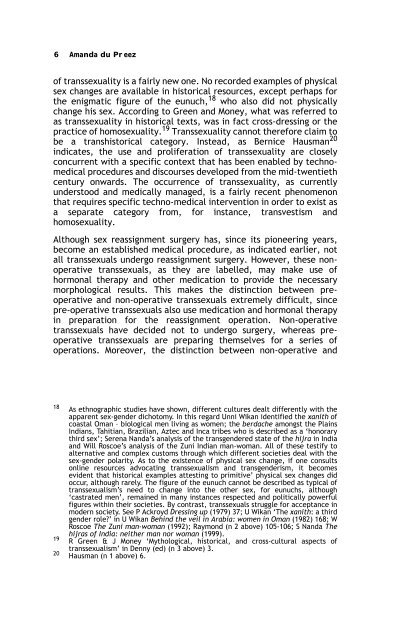Sex, Gender, Becoming - PULP
Sex, Gender, Becoming - PULP
Sex, Gender, Becoming - PULP
You also want an ePaper? Increase the reach of your titles
YUMPU automatically turns print PDFs into web optimized ePapers that Google loves.
6 Amanda du Preez<br />
of transsexuality is a fairly new one. No recorded examples of physical<br />
sex changes are available in historical resources, except perhaps for<br />
the enigmatic figure of the eunuch, 18 who also did not physically<br />
change his sex. According to Green and Money, what was referred to<br />
as transsexuality in historical texts, was in fact cross-dressing or the<br />
practice of homosexuality. 19 Transsexuality cannot therefore claim to<br />
be a transhistorical category. Instead, as Bernice Hausman 20<br />
indicates, the use and proliferation of transsexuality are closely<br />
concurrent with a specific context that has been enabled by technomedical<br />
procedures and discourses developed from the mid-twentieth<br />
century onwards. The occurrence of transsexuality, as currently<br />
understood and medically managed, is a fairly recent phenomenon<br />
that requires specific techno-medical intervention in order to exist as<br />
a separate category from, for instance, transvestism and<br />
homosexuality.<br />
Although sex reassignment surgery has, since its pioneering years,<br />
become an established medical procedure, as indicated earlier, not<br />
all transsexuals undergo reassignment surgery. However, these nonoperative<br />
transsexuals, as they are labelled, may make use of<br />
hormonal therapy and other medication to provide the necessary<br />
morphological results. This makes the distinction between preoperative<br />
and non-operative transsexuals extremely difficult, since<br />
pre-operative transsexuals also use medication and hormonal therapy<br />
in preparation for the reassignment operation. Non-operative<br />
transsexuals have decided not to undergo surgery, whereas preoperative<br />
transsexuals are preparing themselves for a series of<br />
operations. Moreover, the distinction between non-operative and<br />
18 As ethnographic studies have shown, different cultures dealt differently with the<br />
apparent sex-gender dichotomy. In this regard Unni Wikan identified the xanith of<br />
coastal Oman – biological men living as women; the berdache amongst the Plains<br />
Indians, Tahitian, Brazilian, Aztec and Inca tribes who is described as a ‘honorary<br />
third sex’; Serena Nanda’s analysis of the transgendered state of the hijra in India<br />
and Will Roscoe’s analysis of the Zuni Indian man-woman. All of these testify to<br />
alternative and complex customs through which different societies deal with the<br />
sex-gender polarity. As to the existence of physical sex change, if one consults<br />
online resources advocating transsexualism and transgenderism, it becomes<br />
evident that historical examples attesting to primitive’ physical sex changes did<br />
occur, although rarely. The figure of the eunuch cannot be described as typical of<br />
transsexualism’s need to change into the other sex, for eunuchs, although<br />
‘castrated men’, remained in many instances respected and politically powerful<br />
figures within their societies. By contrast, transsexuals struggle for acceptance in<br />
modern society. See P Ackroyd Dressing up (1979) 37; U Wikan ‘The xanith: a third<br />
gender role?’ in U Wikan Behind the veil in Arabia: women in Oman (1982) 168; W<br />
Roscoe The Zuni man-woman (1992); Raymond (n 2 above) 105-106; S Nanda The<br />
hijras of India: neither man nor woman (1999).<br />
19 R Green & J Money ‘Mythological, historical, and cross-cultural aspects of<br />
transsexualism’ in Denny (ed) (n 3 above) 3.<br />
20 Hausman (n 1 above) 6.
















